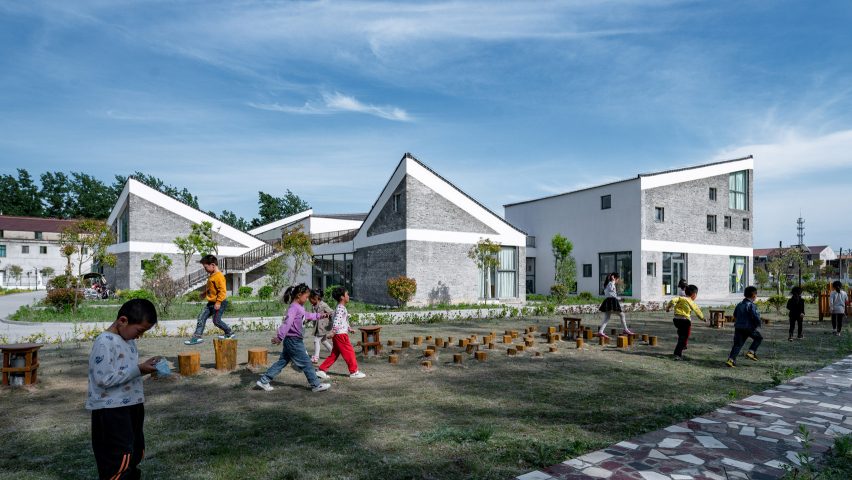The Jiangsu Beisha Kindergarten in China has been conceived as a miniature village, with a cluster of house-like structures clustered around a square and connected via winding paths and raised walkways.
Beijing and Frankfurt-based practice Crossboundaries has designed the kindergarten, in the village of Beisha in China's Funing County, as part of a local government initiative to alleviate a shortage of preschool education in rural areas.
The rural kindergarten is designed to function look like and function as a miniature village.
"Finding the appropriate scale for the project was a crucial starting point of this design," explained Crossboundaries.
"The Beisha Kindergarten functions as a smaller, modified version of a village with the scale giving children a sense of familiarity, introducing novelty and engaging curiosity."
Designed as an alternative to the homogenous, repetitive nature of many school buildings in more urban areas, here classroom are placed within a mix of individual one and two-storey blocks or "houses". Larger separate blocks contain for office, canteen and infirmary spaces.
"A typical school form, enclosed by prismatic volumes and a repetitive facade that blocks off the surrounding and limits the view with its protective, city logic would be a foreign object in this setting," said the architecture studio.
A combination of local recycled brick and white plaster were used to give each of these blocks a subtly different appearance, animated by different roof pitches that animate the project's silhouette.
Large upper-level windows and small openings facing inwards towards the courtyard create a variety of visual connections between each block, and skylights help ensure ample natural light.
At ground level the blocks are connected by glass corridors that enclose the central courtyard. Staircases lead up to a raised platform that surrounds the centre of the kindergarten, connecting to some blocks at first floor level and running alongside the roofs of others.
This vantage point gives views out over the surrounding plains and forests, as well as the green spaces nestled between the scheme's blocks below.
"The second floor pathways are not just a connection between areas, they combine to form a platform of exploration for children," said the studio.
"Once you are up on the second floor your experience is overtaken by the dynamic slopes of the roofs - this little shift in perspective enables the children to expand their everyday spatial experience."
Many Kindergarten projects attempt to break up a large, single structure into a collection of smaller units that activate external spaces.
Tracks Architectes recently designed a kindergarten in France as a row of gabled structures, and in Vietnam, Kientruc O's Chuon Chuon Kim Kintergarten took the form of a cluster of brick houses.
Photography is by Wu Qingshan, HaoHongyi, Mini Liu.

